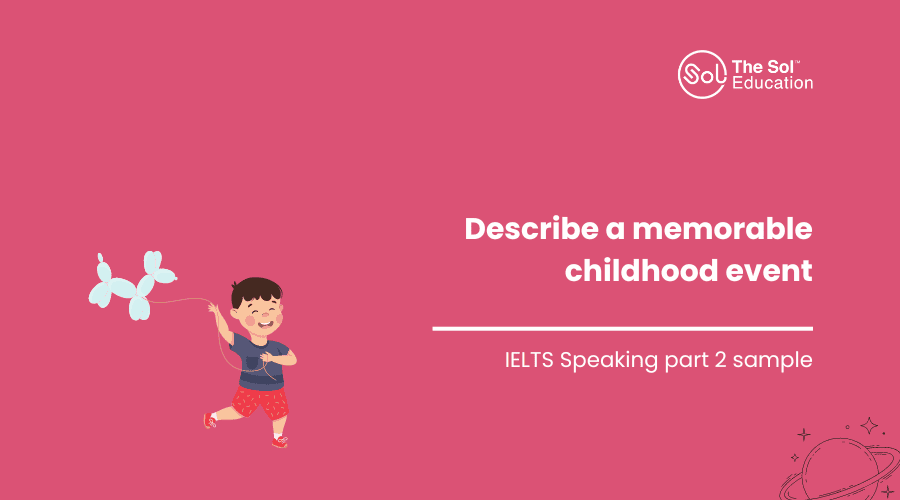IELTS Speaking part 2 sample Describe a memorable childhood event. Cùng SOL chữa đề IELTS Speaking part 2, part 3 topic Describe a memorable childhood event nhé.
IELTS Speaking part 2 sample Describe a memorable childhood event. Cùng SOL chữa đề IELTS Speaking part 2, part 3 topic Describe a memorable childhood event nhé.

IELTS Speaking part 2
1. Đề bài
Describe a memorable childhood event
You should say
- What event it was
- What do you remember about it
- Why it was memorable
2. Sample answer
One of the most memorable childhood events that I cherish happened during my primary school years, around the age of eight. It was a family trip to the seaside during our summer vacation.
What stands out vividly in my memory is the sheer joy of building sandcastles on the beach with my parents and younger sister. The sun was shining brightly, and the sound of waves crashing on the shore created a soothing melody. The beach was bustling with families enjoying the summer break.
I remember the laughter, the excitement of running back and forth to the water to fill our buckets, and the meticulous construction of elaborate sand structures. My parents played an active role in our sandy creations, adding their artistic touch to our miniature kingdom. It was a simple yet magical moment of family bonding and shared creativity.
The event was particularly memorable because it encapsulated the essence of childhood joy and family togetherness. The freedom to play, the warmth of the sun, and the love and laughter shared within our little sandcastle world made it a cherished memory that I revisit often. It was a moment of pure happiness, symbolizing the carefree and delightful spirit of my childhood.
In summary, this memorable childhood event was a snapshot of carefree joy, family connection, and the magic of simple pleasures, creating a lasting imprint on my heart.
Từ vựng IELTS hữu ích:
- vividly /ˈvɪvɪdli/ (adv): rõ ràng, sống động
- sheer joy /ʃɪər ʤɔɪ/ (n): niềm vui tột đỉnh
- shining brightly /ˈʃaɪnɪŋ ˈbraɪtli/ (phr): chiếu sáng sáng chói
- waves crashing /weɪvz ˈkræʃɪŋ/ (n): sóng vỗ
- soothing /ˈsuːðɪŋ/ (adj): làm dịu
- bustling /ˈbʌsəlɪŋ/ (adj): sôi động, náo nhiệt
- excitement /ɪkˈsaɪtmənt/ (n): sự hào hứng, phấn khích
- meticulous /məˈtɪkjʊləs/ (adj): tỉ mỉ, cẩn thận
- construction /kənˈstrʌkʃən/ (n): sự xây dựng
- elaborate /ɪˈlæbərət/ (adj): tinh vi, công phu
- sand structures /sænd ˈstrʌktʃərz/ (n): cấu trúc cát
- artistic touch /ɑrˈtɪstɪk tʌʧ/ (n): sự chạm tay nghệ thuật
- simple yet magical moment /ˈsɪmpəl jɛt ˈmæʤɪkəl ˈmoʊmənt/ (n): khoảnh khắc đơn giản nhưng kỳ diệu
- family bonding /ˈfæməli ˈbɒndɪŋ/ (n): sự gắn kết gia đình
- shared creativity /ʃɛrd ˌkriːeɪˈtɪvəti/ (n): sự sáng tạo chung
- snapshot /ˈsnæpʃɒt/ (n): bức ảnh chụp nhanh
- carefree joy /ˈkɛrˌfri dʒɔɪ/ (n): niềm vui không lo lắng
- lasting imprint /ˈlæstɪŋ ˈɪmprɪnt/ (n): dấu ấn lâu dài
IELTS Speaking part 3
1. What do children often remember from their childhood?
Childhood memories are often shaped by impactful experiences and emotions. Children tend to remember moments of joy, family gatherings, and significant events like birthdays or holidays. Additionally, interactions with friends, early educational experiences, and explorations of the surrounding environment contribute to a child's enduring memories.
2. Why do children often remember their childhood?
The formative years of childhood are marked by rapid cognitive and emotional development. The brain's plasticity during this period enhances memory formation, making childhood memories more vivid and enduring. Furthermore, the emotional significance attached to childhood experiences creates lasting imprints in the memory, influencing individuals throughout their lives.
- rapid /ˈræpɪd/ (adj): nhanh chóng
- cognitive /ˈkɒɡnɪtɪv/ (adj): nhận thức
- emotional development /ɪˈməʊʃənl dɪˈvɛləpmənt/ (n): sự phát triển cảm xúc
- brain's plasticity /breɪnz plæˈstɪsəti/ (n): tính linh hoạt của não
- enhances /ɪnˈhænsɪz/ (v): tăng cường
- memory formation /ˈmɛməri fɔˈmeɪʃən/ (n): quá trình hình thành trí nhớ
- vivid /ˈvɪvɪd/ (adj): sống động
- enduring /ɪnˈdjʊərɪŋ/ (adj): bền vững, lâu dài
- emotional significance /ɪˈmoʊʃənl sɪɡˈnɪfɪkəns/ (n): ý nghĩa cảm xúc
- lasting imprints /ˈlæstɪŋ ˈɪmprɪnts/ (n): dấu ấn lâu dài
3. Can a bad childhood affect a child’s behavior when they grow up?
Undoubtedly, a challenging or adverse childhood can significantly impact a person's behavior in adulthood. Experiences such as trauma, neglect, or instability can shape one's personality, influencing interpersonal relationships, decision-making, and emotional well-being. However, it's important to note that individuals can overcome these challenges through resilience, support, and interventions, showcasing the potential for positive growth despite a difficult upbringing.
- trauma /ˈtrɔːmə/ (n): chấn thương, sốc
- neglect /nɪˈɡlɛkt/ (n): sự sao lãng, bỏ bê
- instability /ˌɪnstəˈbɪlɪti/ (n): sự không ổn định
- shape /ʃeɪp/ (v): hình thành, tạo hình
- personality /ˌpɜrsəˈnælɪti/ (n): tính cách
- influence /ˈɪnfluəns/ (v): ảnh hưởng
- interpersonal relationships /ˌɪntərˈpɜrsənl rɪˈleɪʃənʃɪps/ (n): mối quan hệ giữa cá nhân
- decision-making /dɪˈsɪʒənˌmeɪkɪŋ/ (n): quyết định
- emotional well-being /ɪˈmoʊʃənl wɛlˈbiːɪŋ/ (n): sức khỏe tinh thần
- resilience /rɪˈzɪljəns/ (n): sự dai dẳng, sự kiên cường
- support /səˈpɔːrt/ (n): sự hỗ trợ
- intervention /ˌɪntərˈvɛnʃən/ (n): sự can thiệp
4. How can parents create a memorable childhood for a child?
Creating a memorable childhood involves a holistic approach, encompassing emotional, educational, and recreational aspects. Parents can foster positive memories by engaging in meaningful activities, spending quality time together, and encouraging a supportive environment. Celebrating milestones, promoting curiosity through educational experiences, and nurturing a sense of security contribute to the formation of lasting and cherished childhood memories.
- holistic /hoʊˈlɪstɪk/ (adj): toàn diện, toàn bộ
- approach /əˈproʊtʃ/ (n): cách tiếp cận
- encompassing /ɪnˈkʌmpəsɪŋ/ (adj): bao gồm
- emotional /ɪˈmoʊʃənl/ (adj): về cảm xúc
- educational /ˌɛdʒʊˈkeɪʃənl̩/ (adj): về giáo dục
- recreational /ˌrɛkrɪˈeɪʃənl̩/ (adj): về giải trí, vui chơi
- foster /ˈfɒstər/ (v): nuôi dưỡng, thúc đẩy
- positive memories /ˈpɒzətɪv ˈmɛməriz/ (n): kí ức tích cực
- engaging /ɪnˈɡeɪdʒɪŋ/ (adj): thú vị, hấp dẫn
- meaningful activities /ˈmiːnɪŋfəl ækˈtɪvətiz/ (n): hoạt động ý nghĩa
- spending quality time /ˈspɛndɪŋ ˈkwɒlɪti taɪm/ (phr): dành thời gian chất lượng
- encouraging /ɪnˈkɜrɪʤɪŋ/ (adj): khích lệ, động viên
- supportive environment /səˈpɔːrtɪv ɪnˈvaɪrənmənt/ (n): môi trường hỗ trợ
- celebrating milestones /ˈsɛlɪbreɪtɪŋ ˈmaɪlˌstoʊnz/ (phr): kỷ niệm những cột mốc quan trọng
- promoting curiosity /prəˈmoʊtɪŋ kjʊriˈɒsɪti/ (phr): khuyến khích sự tò mò
- nurturing /ˈnɜrtʃərɪŋ/ (v): nuôi dưỡng, chăm sóc
- sense of security /sɛns ʌv sɪˈkjʊrɪti/ (n): cảm giác an toàn
5. Can children be negatively affected by their classmates?
Peer interactions play a crucial role in a child's development, and while positive friendships can enhance social skills, negative influences may have adverse effects. Bullying or unhealthy peer dynamics can impact a child's self-esteem and behavior. Therefore, fostering a positive school culture, promoting empathy, and providing resources for conflict resolution can mitigate potential negative influences and contribute to a supportive peer environment.
- peer interactions /pɪr ˌɪntərˈækʃənz/ (n): tương tác với bạn bè
- crucial /ˈkruːʃəl/ (adj): quan trọng, quyết định
- development /dɪˈvɛləpmənt/ (n): sự phát triển
- enhance /ɪnˈhæns/ (v): nâng cao, tăng cường
- social skills /ˈsoʊʃəl skɪlz/ (n): kỹ năng giao tiếp xã hội
- negative influences /ˈnɛɡətɪv ˈɪnflʊənsɪz/ (n): ảnh hưởng tiêu cực
- adverse effects /ˈædvɜrs ɪˈfɛkts/ (n): tác động bất lợi
- bullying /ˈbʊliɪŋ/ (n): hành vi bắt nạt
- unhealthy peer dynamics /ʌnˈhɛlθi pɪr daɪˈnæmɪks/ (n): mối quan hệ đồng trang lứa không lành mạnh
- self-esteem /sɛlf ɪˈstim/ (n): lòng tự trọng
- promoting empathy /prəˈmoʊtɪŋ ˈɛmpəθi/ (v): khuyến khích sự đồng cảm
- providing resources /prəˈvaɪdɪŋ ˈriːsɔːrsɪz/ (v): cung cấp tài nguyên
- conflict resolution /ˈkɒnflɪkt ˌrɛzəˈluːʃən/ (n): giải quyết mâu thuẫn
- mitigate /ˈmɪtɪɡeɪt/ (v): làm giảm bớt, giảm nhẹ
6. What kind of online materials are harmful to a child’s mindset?
Online content can have both positive and negative impacts on a child's mindset. Harmful materials include explicit or violent content, inappropriate language, and misinformation. Exposure to such content can negatively shape a child's values, behavior, and perception of the world. It is crucial for parents to monitor and regulate online activities, ensuring access to age-appropriate and educational content while protecting children from potentially harmful materials.
- harmful materials /ˈhɑrmfəl məˈtɪriəlz/ (n): tài liệu có hại
- explicit /ɪkˈsplɪsɪt/ (adj): rõ ràng, không mờ nhạt
- violent content /ˈvaɪələnt ˈkɒntɛnt/ (n): nội dung bạo lực
- inappropriate language /ɪnəˈproʊpriət ˈlæŋɡwɪdʒ/ (n): ngôn ngữ không thích hợp
- misinformation /ˌmɪsɪnfərˈmeɪʃən/ (n): thông tin sai lệch
- exposure to /ɪkˈspoʊʒər tuː/ (n): tiếp xúc với
- negatively shape /ˈnɛɡətɪvli ʃeɪp/ (v): tạo hình tiêu cực
- crucial /ˈkruːʃəl/ (adj): quan trọng, quyết định
- monitor and regulate /ˈmɒnɪtər ænd ˈrɛɡjʊleɪt/ (v): giám sát và điều chỉnh
- online activities /ˈɒnˌlaɪn ækˈtɪvɪtiz/ (n): hoạt động trực tuyến
- ensuring access to /ɛnˈʃʊərɪŋ ˈæksɛs tuː/ (v): đảm bảo truy cập vào
- age-appropriate /eɪdʒ əˈproʊpriˌeɪt/ (adj): phù hợp với độ tuổi
- educational content /ˌɛdʒʊˈkeɪʃənl ˈkɒntɛnt/ (n): nội dung giáo dục
- protecting children /prəˈtɛktɪŋ ˈtʃɪldrən/ (v): bảo vệ trẻ em
- potentially harmful materials /pəˈtɛnʃəli ˈhɑrmfəl məˈtɪriəlz/ (n): tài liệu tiềm ẩn nguy hại
Để làm tốt phần thi IELTS Speaking, bạn chỉ nên tham khảo các câu trả lời trên của SOL để xem cách diễn đạt ý, từ vựng hoặc ý tưởng chứ đừng học thuộc và bê nguyên nội dung vào bài thi của mình nhé. Và luôn phải tìm hiểu thật kỹ Tiêu chí chấm điểm của một bài thi IELTS Speaking. Hãy luyện tập bằng cách ghi âm lại phần nói của mình và nghe lại, đây là một cách rất hữu ích để luyện speaking và tìm ra điểm chưa tốt của mình luôn.
Ngoài ra, bạn có thể tham khảo thêm một số bài viết dưới đây của SOL để có thể nói tốt hơn:

